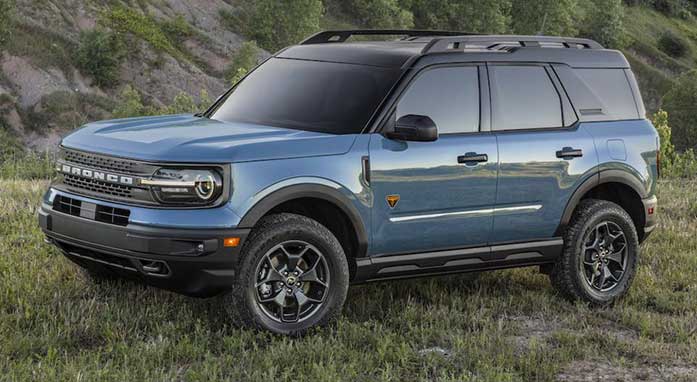
In the world of SUVs, size definitely matters. Some manufacturers, such as Ford, General Motors and others, believe that the bigger the SUV, the better. And many buyers agree. This explains the presence of models like the Escalade, Suburban, Explorer and so on.
On the other hand, sport cutes are simply too small for some people. For them, the Honda HR-V, Hyundai Kona, Toyota C-HR, etc., are just too diminutive and not really practical.
Somewhere in the middle are the compact SUVs – far and away the most popular – Honda CR-V, Toyota RAV4, Hyundai Santa Fe, Ford Escape and so on. These are useful, reasonably economical, affordable and versatile vehicles, which is why they sell in such vast numbers.
To this list we can add the new Ford Bronco, which was introduced earlier this year after a 25-year absence. It’s being built in the same plant as the original, in Wayne, Mich.
Offered in two- and four-door body styles, the new Bronco can be had in six trim levels – from civil around-town livery to “let’s take the doors off and wallow in the mud” configurations.
Two engines are available: 2.3-litre and optional 2.7-litre turbocharged EcoBoost four cylinders, with a 10-speed automatic or, if you choose a two-door, a seven-speed manual. The four-door Sport model I tested had the base engine and automatic transmission.
All models have a four-wheel-drive system and, depending upon the model, various off-road enhancements. These include high ground clearance suspension, locking front and rear axles and a special hard-core Trail package.
And that kind of sets the Bronco apart. This is an SUV that can actually go off-road and is meant to handle the rough stuff. In its heyday, the original Bronco was praised for its off-road ability and Ford is clearly eager to continue this legacy.
The downside – depending on your point of view – is a slightly firmer suspension and harsher handling characteristics. The Bronco definitely rides a little harder than the Ford Escape, but I kind of liked it. Less ambiguous.
Some other highlights:
The auto-stop feature, which is supposed to reduce emissions and save gas over the long haul, is poorly executed. Yes, the vehicle shuts off and restarts at stoplights, but there’s a slight delay that’s annoying and kind of disconcerting. Just enough to irritate the guy behind you.
I think I’ve adjusted to Ford’s rotary shifter. This is used throughout the company’s lineup and works well once you get used to it.
Comfy seats. Unlike some Lincolns I’ve driven lately, the Bronco has front buckets that are firm without punishing the driver. Ford should rip the seats out of its Lincoln models and replace them with these.
The dash instrumentation has a graphic that tells you the speed limit on that particular road. That’s fine, except it starts to flash as soon as you’re one klick over the limit – kind of a built-in electronic traffic cop. I’d disable that feature ASAP. Unfortunately, Ford is using this “safety” feature throughout its lineup.
Room to move. Although it’s not strictly a grocery-getter or hockey mom taxi, the Bronco is fairly spacious. Fold down the second-row seats and you get 2,300 to 2,400 litres (81 cubic feet) of cargo room. The soft-top model apparently has more storage capacity than the hardtop.
This is a lively vehicle. Even the smaller engine, with some 270 horsepower on tap, moves it along nicely. It has excellent reserve power for passing.
What appeals to me the most about the new Bronco is that it’s kind of faithful to the original idea behind SUVs. It’s a manageable size, seems well screwed together, is comfortable, roomy and more than capable off-road.
And that’s where I’d like to take it, next time.
2021 Ford Bronco
Engine: 2.3-litre turbocharged four-cylinder
Transmission: ten-speed automatic
Drive: all-wheel/four-wheel
Horsepower: 270
Torque: 310
Price as tested: $47,449
Fuel economy: 11.1 litres/100 km city and 8.9 litres/100 km highway, with regular fuel
Some alternatives: Subaru Forester, Honda CR-V, Nissan Rogue, Toyota RAV4, Jeep Renegade, Chevrolet Trailblazer, Mazda CX-30
Ted Laturnus has been an automotive journalist since 1976. He was named Canadian Automobile Journalist of the Year twice and is past president of the Automobile Journalists Association of Canada (AJAC). For interview requests, click here.
The views, opinions and positions expressed by columnists and contributors are the authors’ alone. They do not inherently or expressly reflect the views, opinions and/or positions of our publication.
© Troy Media
Troy Media is an editorial content provider to media outlets and its own hosted community news outlets across Canada.




